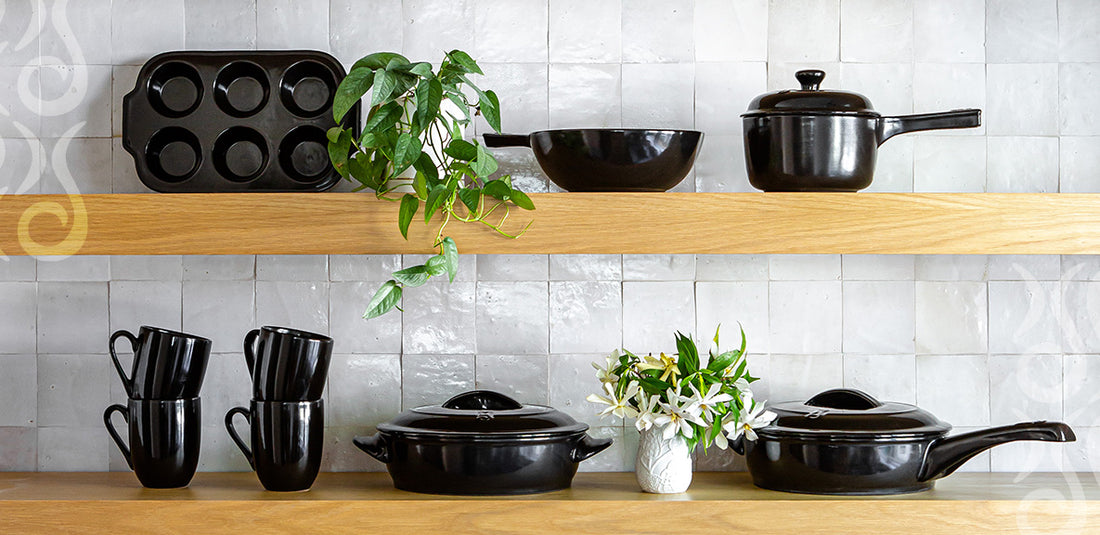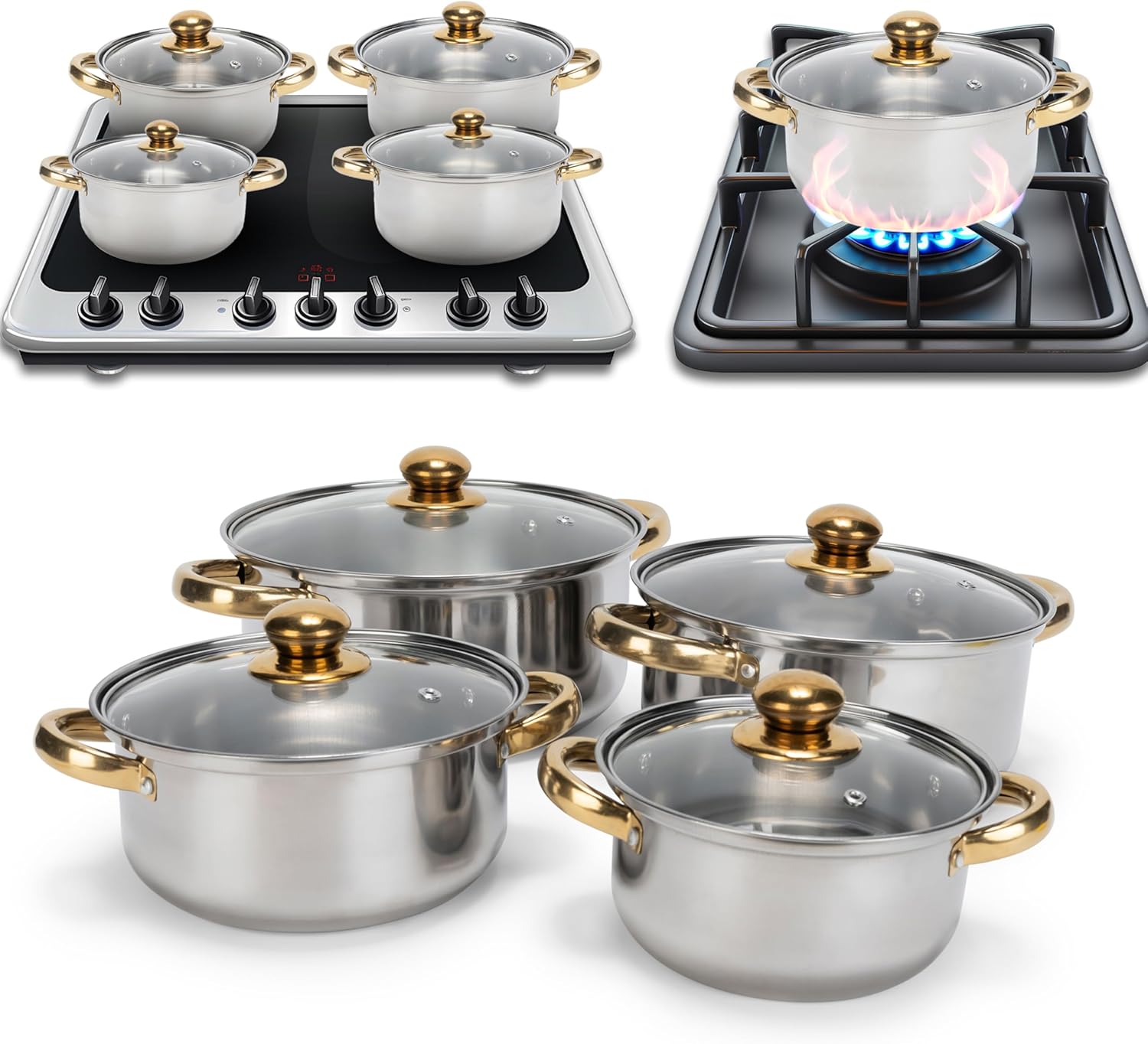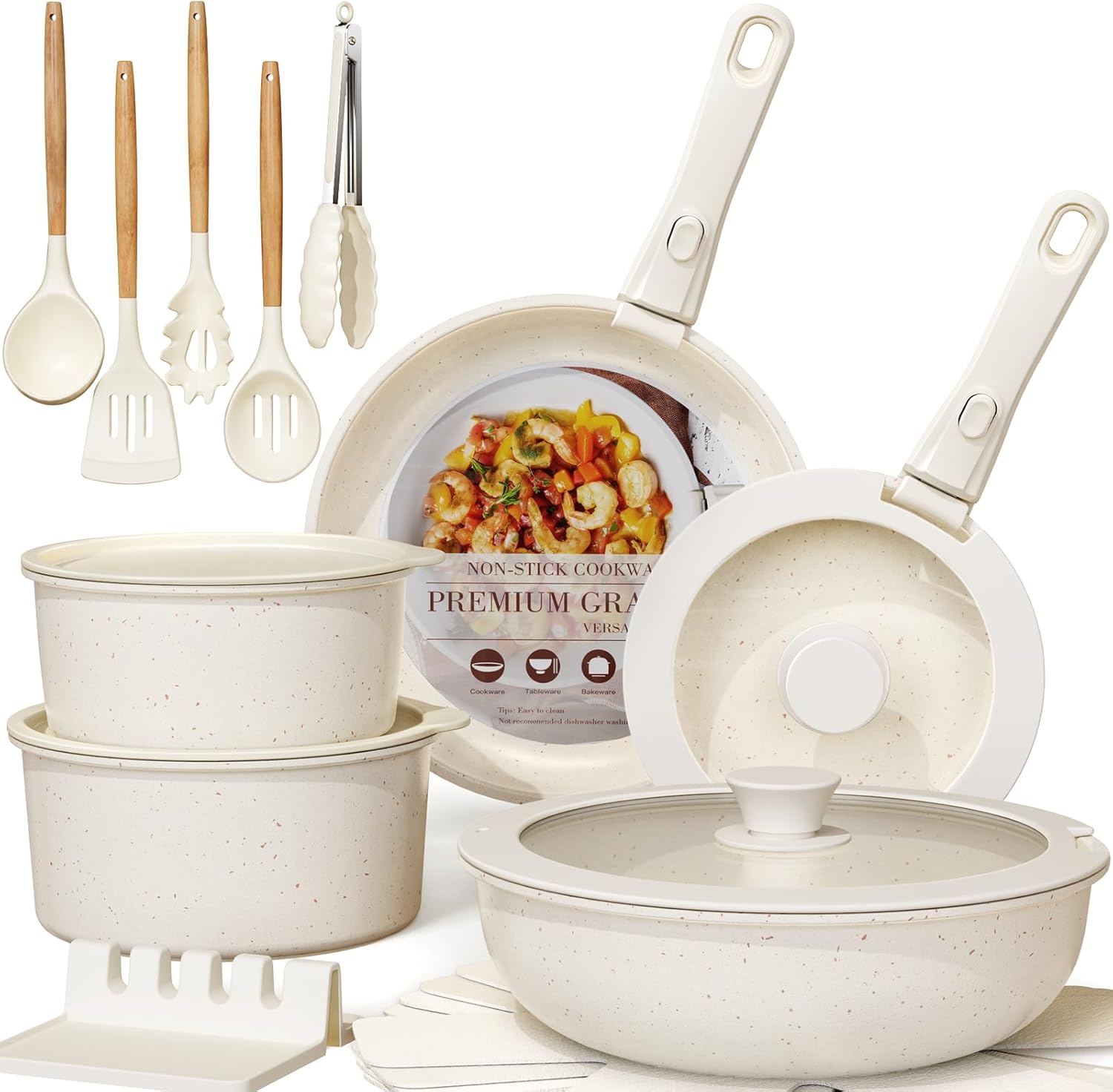Choose eco-friendly cookware by selecting materials like cast iron, stainless steel, or ceramic. Avoid non-stick coatings containing harmful chemicals.
How to Choose Eco-Friendly Cookware for Your Kitchen:In today’s world, eco-friendly choices matter, even in the kitchen. Eco-friendly cookware reduces your carbon footprint and promotes healthier cooking. Options like cast iron, stainless steel, and ceramic are durable and free from harmful chemicals. These materials not only ensure even heat distribution but also last longer, reducing waste.
Avoid non-stick coatings that release toxins at high temperatures. Instead, choose cookware that supports sustainable practices and ensures safety for your family. Making informed choices about cookware contributes to a healthier planet and lifestyle. Invest in quality, eco-friendly cookware for a greener kitchen.

Credit: www.amazon.com
Importance Of Eco-friendly Cookware
Eco-friendly cookware is essential for a sustainable kitchen. Choosing the right cookware can make a big difference. It benefits the environment and your health.
Environmental Impact
Eco-friendly cookware reduces waste and pollution. It is made from sustainable materials. These materials are often biodegradable or recyclable. This helps to lower your carbon footprint.
Traditional cookware often contains harmful chemicals. These chemicals can leach into the soil and water. Eco-friendly options avoid these dangerous substances. They are safer for the planet.
| Traditional Cookware | Eco-Friendly Cookware |
|---|---|
| Contains harmful chemicals | Made from natural materials |
| Non-recyclable | Often recyclable |
| High carbon footprint | Low carbon footprint |
Health Benefits
Eco-friendly cookware is better for your health. It often uses non-toxic materials. This means no harmful chemicals enter your food.
Common materials include cast iron, stainless steel, and ceramic. These materials are safe and do not leach into food. This keeps your meals healthy and free from toxins.
- Cast Iron: Durable and chemical-free
- Stainless Steel: Non-reactive and safe
- Ceramic: Naturally non-stick and toxin-free
Materials To Consider
Choosing eco-friendly cookware is vital for a sustainable kitchen. The right materials ensure healthy cooking and reduce environmental impact. Below are some key materials to consider for eco-friendly cookware.
Ceramic
Ceramic cookware is made from natural clay. It is free from harmful chemicals. This material ensures even heat distribution. Ceramic cookware is ideal for slow cooking. It is non-stick and easy to clean. Always choose 100% ceramic for best results.
Cast Iron
Cast iron cookware is durable and long-lasting. It retains heat well and is perfect for high-heat cooking. Cast iron requires seasoning to maintain its non-stick surface. It adds a small amount of iron to your food, which is beneficial. Make sure to dry it completely to avoid rust.
Stainless Steel
Stainless steel is a popular choice for eco-friendly cookware. It is non-reactive and does not leach chemicals into food. Stainless steel is durable and resistant to scratches. It is ideal for browning and searing. Choose high-quality stainless steel for the best performance.
| Material | Pros | Cons |
|---|---|---|
| Ceramic |
|
|
| Cast Iron |
|
|
| Stainless Steel |
|
|
Non-toxic Coatings
Choosing eco-friendly cookware means picking options with non-toxic coatings. Non-toxic coatings help maintain healthy cooking and keep harmful chemicals away. Learn about the best choices for safe cookware.
Ptfe-free Options
PTFE (Polytetrafluoroethylene) is found in many non-stick pans. It can release harmful fumes when overheated. Choosing PTFE-free cookware ensures safety and reduces chemical exposure. Some popular PTFE-free options include:
- Cast Iron: Durable and naturally non-stick when seasoned.
- Stainless Steel: Long-lasting and does not leach chemicals.
- Carbon Steel: Lightweight and develops a non-stick patina over time.
Ceramic Coatings
Ceramic-coated cookware is another safe and eco-friendly choice. Ceramic coatings are free from PTFE and PFOA. They provide a non-stick surface without harmful chemicals. Ceramic cookware is easy to clean and available in various colors and styles. Key benefits of ceramic coatings include:
| Benefit | Description |
|---|---|
| Non-Stick | Food slides off easily, making cooking and cleaning simple. |
| Heat Resistant | Can withstand high temperatures without releasing toxins. |
| Durable | Long-lasting and resistant to scratches and chips. |
To choose the best eco-friendly cookware, consider both PTFE-free and ceramic options. Both provide safe cooking experiences and help protect the environment.
Durability And Longevity
Choosing eco-friendly cookware is essential for a green kitchen. To get the best value, focus on durability and longevity. Durable cookware lasts longer and reduces waste. Here’s how to ensure your cookware meets these criteria.
Wear And Tear
Eco-friendly cookware should resist wear and tear. Look for materials like cast iron, stainless steel, and ceramic. These materials are known for their strength and durability. Avoid cookware that scratches easily or loses its coating.
Check for reviews and ratings. Customer feedback can indicate how well the cookware holds up. Durable cookware will save money in the long run.
Maintenance Tips
Proper maintenance extends the life of your cookware. Follow these maintenance tips:
- Wash cookware by hand to avoid scratches.
- Use non-abrasive sponges for cleaning.
- Dry cookware immediately to prevent rust.
- Season cast iron regularly to maintain its surface.
- Avoid using metal utensils on non-stick surfaces.
Store cookware properly to avoid damage. Stack with care or use hooks for hanging.
| Material | Durability | Maintenance |
|---|---|---|
| Cast Iron | High | Season regularly, avoid water |
| Stainless Steel | High | Hand wash, dry immediately |
| Ceramic | Medium | Use non-abrasive sponges |
By following these tips, you can choose and maintain cookware that lasts for years.
Energy Efficiency
Choosing eco-friendly cookware is a smart way to reduce your kitchen’s carbon footprint. One crucial factor to consider is energy efficiency. Efficient cookware saves energy and reduces cooking time, which is great for the environment and your wallet.
Heat Distribution
Good heat distribution ensures your food cooks evenly. Uneven heat can cause hot spots, burning some areas while leaving others undercooked. Cookware made from materials like stainless steel and cast iron offers excellent heat distribution. These materials heat up evenly and retain heat longer.
| Material | Heat Distribution |
|---|---|
| Stainless Steel | Excellent |
| Cast Iron | Very Good |
| Copper | Outstanding |
| Aluminum | Good |
Induction Compatibility
Induction cooktops are highly energy-efficient. They heat cookware using electromagnetic fields. Not all cookware works with induction cooktops. Look for cookware with a magnetic base. This ensures it will work on induction cooktops.
- Check for a magnetic base.
- Choose cookware labeled “induction-compatible.”
- Stainless steel and cast iron are usually good choices.
Using the right cookware on an induction stove saves energy. It also cooks food faster, making it a win-win for your kitchen and the planet.
Cost Considerations
Choosing eco-friendly cookware involves considering various factors, including cost. Understanding the cost implications helps make an informed decision. Let’s break down the cost considerations into two main parts: Initial Investment and Long-Term Savings.
Initial Investment
Eco-friendly cookware often requires a higher initial investment. These products typically use quality materials. This includes recycled steel, ceramic, and cast iron. High-quality materials tend to cost more. Below is a table comparing initial costs:
| Cookware Type | Eco-Friendly Material | Initial Cost |
|---|---|---|
| Frying Pan | Ceramic | $30 – $60 |
| Stock Pot | Recycled Steel | $50 – $100 |
| Skillet | Cast Iron | $40 – $80 |
Understanding these costs helps in budgeting. It is also important to note that these products are durable. This ensures they last longer, which brings us to the next point.
Long-term Savings
Investing in eco-friendly cookware results in long-term savings. These products are built to last. This means fewer replacements over time. Here are some benefits:
- Reduced need for frequent replacements
- Lower long-term costs
- Energy-efficient cooking
Eco-friendly cookware often has better heat distribution. This results in energy savings. Over the years, this can lead to significant savings on utility bills.
Choosing durable cookware also reduces waste. This adds another layer of savings by reducing disposal costs. All these factors contribute to long-term financial benefits.
Consider these cost factors when choosing your next set of eco-friendly cookware. It can make a significant difference in both your wallet and the environment.
Ethical Manufacturing
Choosing eco-friendly cookware is more than just selecting green materials. Understanding ethical manufacturing practices is key. This involves fair labor, sustainable production, and transparent supply chains. Let’s explore how these aspects contribute to a truly eco-friendly kitchen.
Fair Labor Practices
Fair labor practices ensure workers are treated well. This includes fair wages, safe working conditions, and reasonable hours. Look for brands that are certified by organizations like Fair Trade or B Corp. These certifications guarantee that workers’ rights are protected.
- Fair wages
- Safe working conditions
- Reasonable hours
Supporting brands that follow fair labor practices helps build a better world. Workers should not suffer for our kitchen needs.
Sustainable Production
Sustainable production means using processes that are kind to the Earth. This includes reducing waste, using renewable energy, and recycling materials. Look for cookware made from recycled or recyclable materials. Brands that use solar or wind energy in production are also good choices.
| Aspect | Details |
|---|---|
| Waste Reduction | Minimal packaging, efficient manufacturing |
| Renewable Energy | Solar, wind, or hydro power |
| Recycling | Using recycled or recyclable materials |
Choosing brands that focus on sustainable production helps reduce our carbon footprint. It also ensures our planet stays healthy for future generations.

Credit: xtrema.com
Certifications To Look For
Choosing eco-friendly cookware can be challenging. Certifications help identify products that meet environmental and safety standards. Knowing which certifications to look for can simplify your decision-making process. This section will explore key certifications you should consider.
Eco-labels
Eco-labels indicate that a product meets specific environmental criteria. These labels help you make informed choices. Here are some common eco-labels to look for:
- Energy Star: Indicates energy-efficient products.
- Green Seal: Certifies products that meet rigorous health and sustainability standards.
- Cradle to Cradle: Ensures products are safe and sustainable throughout their lifecycle.
- USDA Organic: Denotes products made from organic materials.
Safety Standards
Safety standards ensure that cookware is free from harmful substances. Look for these certifications to ensure your cookware is safe:
- FDA Approved: Ensures that materials are safe for food contact.
- LFGB Certification: German certification for food-grade materials.
- NSF International: Verifies that products meet public health standards.
| Certification | Purpose |
|---|---|
| Energy Star | Indicates energy efficiency |
| Green Seal | Certifies health and sustainability |
| FDA Approved | Ensures safety for food contact |
| NSF International | Verifies public health standards |

Credit: www.amazon.com
Frequently Asked Questions
What Is Eco-friendly Cookware?
Eco-friendly cookware is made from sustainable materials. It reduces environmental impact. Examples include cast iron, stainless steel, and ceramic. They avoid harmful chemicals like PFOA and PTFE.
Why Choose Eco-friendly Cookware?
Eco-friendly cookware is safer for health and the environment. It reduces exposure to harmful chemicals. It also promotes sustainable practices. Plus, it often lasts longer than traditional cookware.
Which Materials Are Best For Eco-friendly Cookware?
Best materials include cast iron, stainless steel, and ceramic. These materials are durable and free from harmful chemicals. They also have minimal environmental impact.
How To Identify Eco-friendly Cookware?
Look for labels like “PFOA-free” and “non-toxic. ” Check for sustainable materials like cast iron or stainless steel. Research brands that prioritize eco-friendly practices.
Conclusion
Choosing eco-friendly cookware benefits both your health and the environment. Select materials like cast iron, stainless steel, or ceramic. Prioritize durability and sustainability in your choices. Eco-friendly options can also enhance your cooking experience. Make the switch today and enjoy a greener, healthier kitchen.





Leave a Reply